(c) Jack Ballard
A few kids have the age-old question, “What do you want to be when you grow up?” licked by the time they’re five. An acquaintance of mine recently completed a long career as a nurse, a professional path she’d plotted for herself since first grade. But most of us aren’t so lucky. For many, the ongoing turmoil over the issue reaches a fever pitch when confronted with choosing a college major or taking a first job out of high school. No longer able to kick the can down Commitment Street some are so frustrated by the choice they seem prepared to blindly hurl a dart at the list of options and live with the results. However, decades past the decision most successful American adults advocate for a simpler approach. Take a dispassionate appraisal of your interests and abilities. Pick a career path based on those and life will satisfactorily work itself out.
Planning an elk hunt in unfamiliar territory is similarly bewildering to many outdoorsmen, whether traveling from Wisconsin for a first crack at a wapiti as a whitetail hunter or starting the Subaru in Boulder, Colorado on a quest for elk as a confirmed “locavore.” Tens of thousands of acres of habitat are found on public land in the average elk hunting district in the West. How do you even begin choosing a place to hunt?
Knowing what elk need at various times during the season is the key to success. This entails the ability to “read” habitat in relation to the biological requirements of wapiti in relation to factors such as the ecosystem in which one is hunting, the forage cycle, motorized vehicle routes and disruption to the routines of elk life by humans. With the ability to read habitat, a hunter can methodically rule out the majority of real estate in a hunting district and focus on the areas that will be most productive.
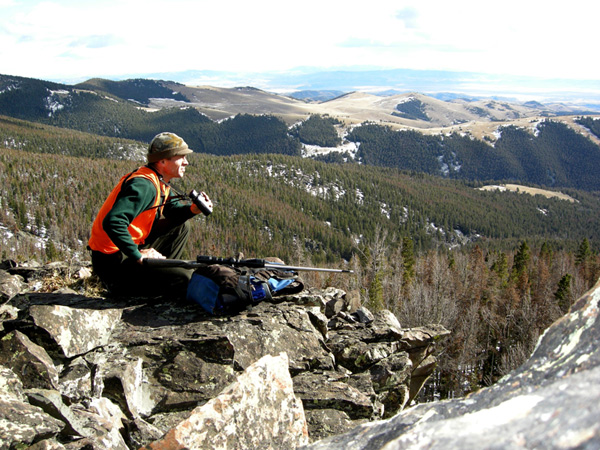
Food (and water), shelter and security have been identified by sociologists as the most basic human needs. Satisfy those, and a person has the building blocks for a good life. The same three elements motivate the activities of elk. Habitat that fails to provide them will be avoided. Areas offering all three in proximity will be “elk magnets.”
Of the members of the deer family, elk are the most eclectic in their diets. Whereas mule deer (and whitetails) consume mostly browse in the fall (in the absence of agricultural crops) and moose are almost exclusively browsers, elk will readily consume both the twigs of brush and deciduous trees along with grass. Leafy plants known as forbs are autumn favorite of elk where available, typically becoming scarcer as the season wears on.
Whether it’s grass, forbs or browse, a common characteristic unites their desirability for elk as food. Green and tender always trump dry and woody. This applies all over but is especially important when reading habitat in arid environments. There’s outstanding elk hunting in places such as the foothills and prairies of mountain states and the pinyon-juniper country of the Southwest, both of which receive far less annual precipitation than the mountains.
In these areas, green forbs and grasses persist in moist pockets long after the majority of the landscape has dried up in late summer. They’re also the spots where deciduous trees and shrubs produce the most new growth, sprouting the palatable twigs at the ends of woody branches favored by elk and deer.
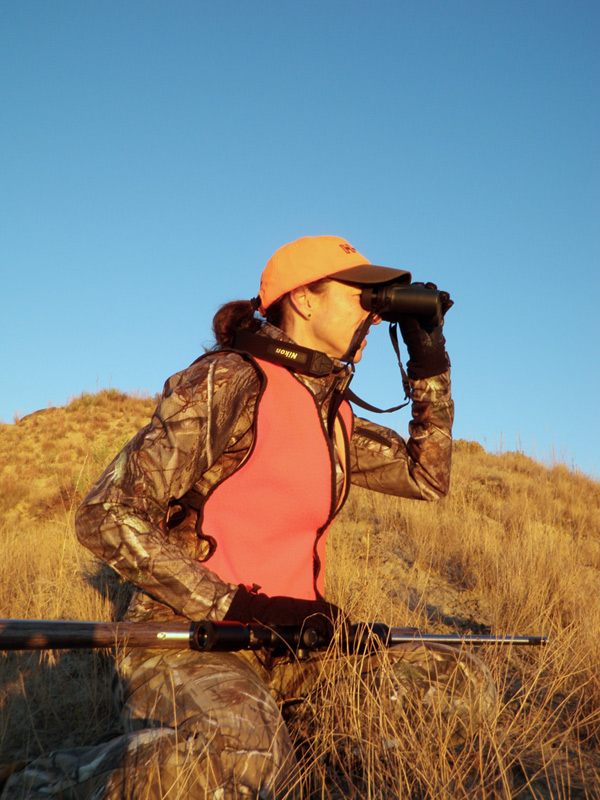
Locating these areas is often as simple as glassing, not for animals, but for the moisture-loving deciduous trees and shrubs that betray the wettest, most productive habitat nooks in the country. In my area that means species like aspen trees and chokecherry bushes in the foothills. Draws with green ash trees and tall sagebrush are similar indicators on the plains.
Last season I hit the foothills not far from home on a late September bird hunt. Gray partridge, sage grouse and sharp-tailed grouse all inhabit the region, mostly on a long, broad bench with plunging draws and finger ridges on its east side. I followed our English Setter along the sagebrush and grass flat for over a mile without encountering a single bird. We paused along the eastern rim as I contemplated dropping off a steep embankment onto a smaller bench where we’d found partridges in the past.
Decision made, my boots skidded down the canted slope. The dog chose a detour onto an even steeper slope that terminated abruptly onto a dished pocket nourishing a stand of aspens and a fringe of evergreens on its uphill side. He didn’t find any birds in its several acres, but he did bump two spike bull elk, one with long tatters of dried velvet flapping from the base of one of its antlers like streamers tied to a kid’s bicycle in a parade. Curious, I made my own loop into the shady abode. Droppings, beds and cropped green grass told the story. The young bulls had been hanging out in the foothills oasis for some time. Though small, its succulent forage proffered them a finer buffet than several square miles of the surrounding, semi-arid habitat.
Reading habitat in relation to forage involves two further considerations. The first is to research to the greatest extent possible the feeding preferences of elk in a particular area during the time of the hunt. For example, research from a mountain range in southwestern Montana identified grasses comprising 62% of plant use by elk during the month of September, with forbs contributing another 34%. Sticky Geranium was a favorite forb. By late October, grass consumption increased to 80% of the elk diet while forbs dropped to 14%. During the entire fall, browse was a very minor portion of the diet. By contrast, a similar project in New Mexico found elk eating 78% browse during the fall and around 16% grass. Two shrubs, oak brush and Wright’s silktassel, were top food items for elk in the two study areas.
Elk are extremely adaptable animals whose diets can shift quite dramatically in relation to the region they inhabit, and annual precipitation and temperature conditions that enhance the growth of certain plant species over others. Savvy hunters who understand the forage preferences of wapiti in their hunting area have the ability to read habitat on the go and be on the alert for particular dietary items especially attractive to local elk. Discover the favorite eats and you’re well on the way to finding your bull.
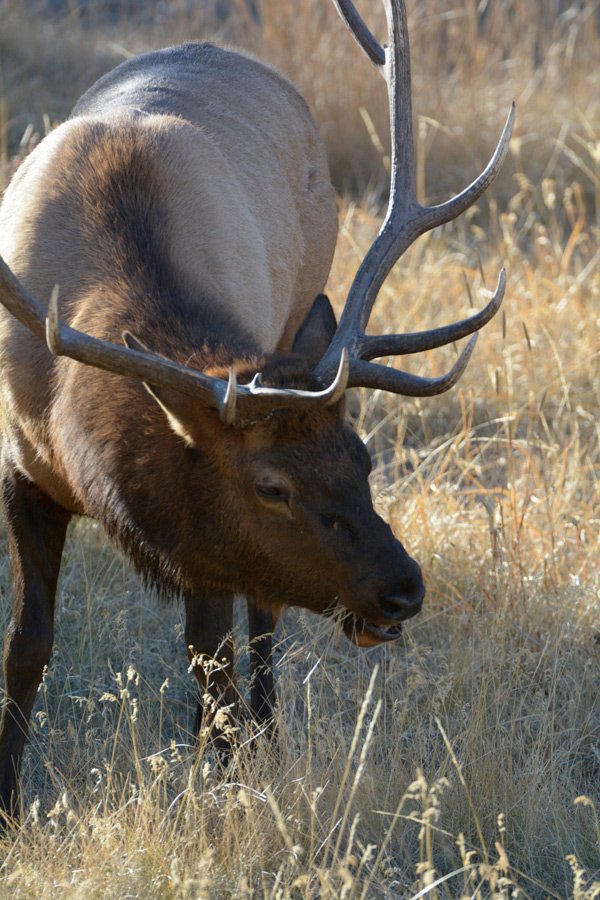
Along the same lines, surface water is critical to elk survival. Where green, succulent forage is present the big brown ungulates can absorb a substantial amount of their required moisture from plants. But once the growing season is past and habitat dries in early autumn reliable water sources become extremely important, especially in arid environments and during drought years.
Water typically isn’t an issue for mountain-dwelling elk. But it’s an imperative on the plains and in the dry habitats of the Southwest. As a general rule, elk will be found within about a mile of reliable water. For example, Montana’s Missouri Breaks region, home to some outstanding trophy bulls, is in a portion of the state receiving modest rainfall and prone to drought. The presence of Fort Peck Reservoir greatly enhances elk habitat in the breaks by providing an annual source of water. During drought years, elk are concentrated in the vicinity of the reservoir and other water sources (stock tanks, smaller reservoirs). Reading habitat in such places means identifying water sources and their reliability during drought in addition to focusing on feed.
Habitat analysis for forage and water must also be tied to a second requirement for elk, security. This means daytime bedding cover that buffers animals from human disturbance during the hunting season while also provided protection from the elements, be it shade during hot days in September or a place to avoid bitterly cold winds in November. Forage adjacent to cover will be used heavily. Attractive food items located a half-mile or more from security may not be munched at all. Waterholes in or adjacent to cover are much more likely to be visited during legal shooting hours than those in the open.
A pair of words capture habitat assessment regarding the forage/security dynamic: edges and pockets. Large swaths of desirable forage (think big burns, expansive sagebrush flats, major meadows) bounded by excellent cover in the form of evergreen forests are perennially attractive to elk. But they’ll stick to the edges, straying from cover as little as possible to find a meal, a phenomenon that becomes even more pervasive as hunting pressure increases.
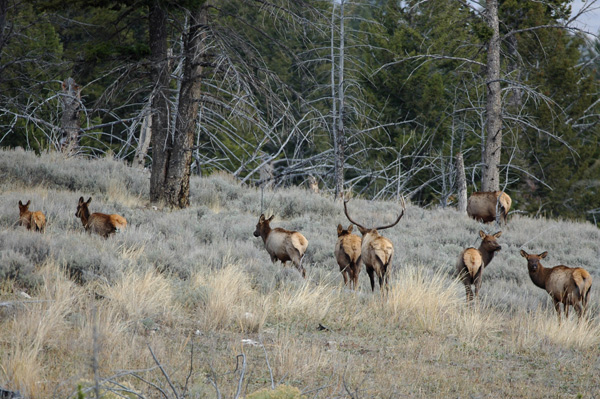
However, not all edges are created equal. Elk are most at home on flat to moderately sloped terrain. They’ll plunge up and down the really steep stuff when pushed, but normally avoid territory with more than a 30-degree slope. Thus, where the edges of a sprawling, grassy park include both steep and gently sloped terrain (up or down) the more navigable portions are the best bets.
In the past decade, folks from my hunting camp have taken a number of elk from just such a place. There’s a fairly long but narrow meadow on a sidehill bounded by timber several miles from our annual encampment. On the upper end it’s vertiginous terrain that ramps the heart-rate into overdrive should a hunter take a direct route upslope. However, at the base of the steep a nearly flat bench offers passage from heavy timber to the opening. That’s the portion of the park’s rim where elk show up. We’ve taken three animals (and missed a couple more) using the exact same travel route in the past several years.
Edges are important to all elk hunters. Pockets are even more so for bull-seekers. These are modest areas of good forage among broad areas of cover. They might be two-acre grassy clearings on a timbered flat, knobs where tree cover yields to shrubs or smallish, backcountry burns where a lightning strike ignited a blaze that burned briefly. Post-rut bulls, reclusive by nature, love such retreats. Those located in lightly pressured areas are a bonus. These seldom show up on a paper map. Satellite mapping imagery is the best to pinpoint them in advance.
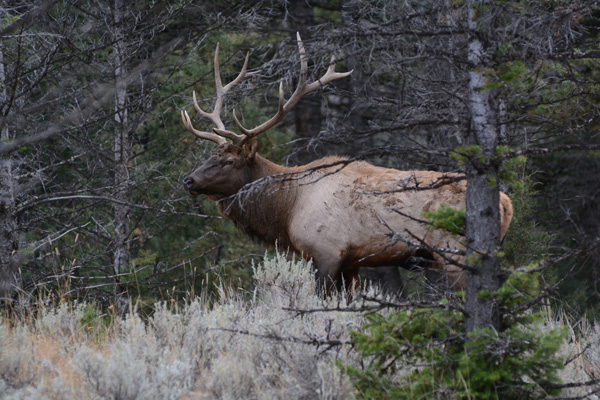
Once found, pockets in secure areas attract bulls year after year. The type of security post-rut stags desire brings up another aspect of reading habitat. Numerous research studies have confirmed that elk on public lands are rebuffed by roads, normally staying a mile or more from motorized travel routes. (I’d peg it at an average of two miles in most of the mountain ranges I hunt in Montana.)
Bull-pockets seem to require even more insulation from intruding hunters. One of those in our hunting area is five miles from any road and almost a mile from a lightly used Forest Service trail. It’s made up of a few thin meadows on a massive, heavily timbered north-facing slope. Our camp killed two fine bulls in its vicinity one season. There’s a physical commitment to get there whether riding or hiking, but it’s consistently about the best place to find a bull on our side of the mountains from late October to mid-November.
There’s a simple way for the befuddled high school senior to make sense of a future with seemingly too many choices. Make a decision based on the needs and desires of the individual and you can’t go wrong. Reading habitat with the same necessities of elk in mind is the best way to find a bull in unfamiliar territory.
